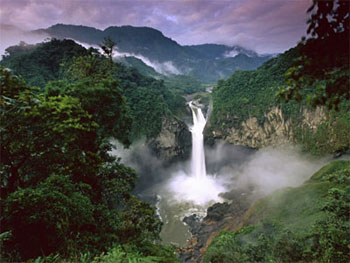Today is a sad day in Ecuador and for people around the world concerned about indigenous rights and the value of pristine rainforests.
Ecuador’s government issued an “environmental permit” (oxymoron!) to drill for oil inside the World Biosphere Reserve, Yasuni National Park. On state television, the environment minister announced that access roads will now be built and oil production would begin as early as 2016. Seismic exploration – which involves dynamite – is underway.
The ecologically complex forest is inhabited by two tribes that still live in voluntary isolation from the developed world.
Our previous article summarizes the situation: Ecuador’s About Face: Yes to Oil Drilling.
Hailed as a model for not extracting oil from the ground, in 2008 President Correa announced Yasuní National Park would be closed to oil drilling, where an estimated 846 million barrels lay untapped – the country’s largest oil reserve and the world’s greatest carbon sink and oxygen supplier.
But the announcement depended on wealthy countries paying Ecuador half of what the recovered oil would be worth – $3.6 billion by 2023. At the time, the world was entering the Great Recession and only about $13 million has been raised. But there’s 10 years left!
Ecuador is the third largest oil producer in South America – pumping over 500,000 barrels of oil a day – but with production ebbing, they are moving into the Yasani. The US has been the biggest oil buyer; future exports will go to China to service its debt.
Ecuador owes $7 billion to China, more than a tenth of its GDP. China helped fund Ecuador’s biggest hydro plant and may soon finance a $12.5 billion oil refinery.
“My understanding is that this is more of a debt issue – it’s because the Ecuadoreans are so dependent on the Chinese to finance their development that they’re willing to compromise in other areas such as social and environmental regulations,” Adam Zuckerman, environmental and human rights campaigner at Amazon Watch, told The Guardian.
The country’s economy is tied to oil and energy consumption has almost doubled over the past decade. While the government says the proceeds will help people out of poverty, those very same people want their forest left alone. Although they own parts of Yasuni, they do not own the oil beneath the land.
The government claims it will hold state oil company Petro Amazonas to the highest standards, even using surveillance drones. But what will they do about the explosions, chainsaws and bulldozers that are making way for oil drilling?
In 2008, Ecuador became the first country in the world to codify the rights of nature into its constitution. Known as the Green Constitution, it recognizes the inalienable rights of ecosystems to exist and flourish, gives people the authority to petition on the behalf of ecosystems, and requires the government to remedy violations of these rights. Bolivia is the only other country that’s done this. It also specifically prohibits extraction of non-renewable resources in protected areas.
Protests are on-going in Ecuador and also in Paris, Houston, Washington DC and Calgary, and so far only three of 16 tracts have been auctioned.
The fight has become treacherous, with the Secretary of Hydrocarbons filing a formal complaint against eight indigenous leaders who have dedicated their lives to defending the Amazon. They are threatened with imprisonment for organizing indigenous communities to oppose Ecuador’s plans to auction off nearly 10 million acres of the Amazon rainforest for oil drilling.
20-Year Lawsuit Against Chevron
Ecuador has already seen the devastating effects of oil production. In the 1970s, Texaco caused rampant oil and chemical spills, simply dumping oil waste into unlined pits, allowing crude to spill everywhere. Over 20 years, it dumped 18 billion gallons of oil sludge into the rainforest, called Chernobyl in the Amazon.

Chevron bought Texaco in 2001 and tribes have continued their 20-year lawsuit for $19 billion in damages. They won in Ecuador’s court, but Chevron refused to pay. Later, Ecuador’s Supreme Court cut that in half, removing the interest that accrued all those years.
Since then, the case has become incredibly complex, with Chevron using every tactic possible. They have been in and out of US and Canadian courts. An Argentina court agreed to freeze Chevron’s assets, but that was over-ruled in the country’s Supreme Court. In the latest ruling, a Canadian appeals court gave tribes the right to pursue enforcement of the $9.5 billion Ecuadorian court judgment against Chevron’s assets in Canada.
“This order will allow us the opportunity to hold Chevron accountable for fleeing the scene of its environmental crimes in Ecuador after a valid judgment was entered against it,” said Pablo Fajardo, the lead Ecuadorian lawyer for the villagers.
Read the full saga and stay informed at Amazon Watch:
